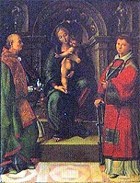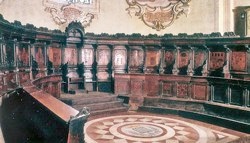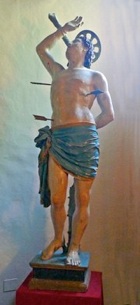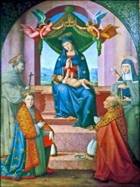

Pompeo di Piergentile Cocchi of Perugia enrolled in the the Arte dei Pittori (Artists’ Guild) in 1523, by which time he was already an established artist. He served as a Prior of Perugia in 1530 and again in 1537.
Pompeo Cocchi had a long association with the Olivetan monks at Montemorcino Vecchio (to the west of Perugia) and, in a will that he wrote in 1544, he asked to be buried in a chapel there that he had painted. However, he was actually buried in San Francesco al Prato, and all of his works at Montemorcino Vecchio have been destroyed or dispersed.
Perugia
Crucifixion (1501?)
This fresco was detached from the wall behind the altar of the Oratorio di San Domenico in the 18th century. It entered the Galleria Nazionale in 1878 and was transferred on to canvas in 1947. It depicts the monumental body of Christ on the Cross, and is set in a landscape.
The fresco has traditionally been associated with the work that was the subject of a payment by the Confraternita di San Domenico to Giannicola di Paolo in 1501. However, this attribution remains a matter for debate. For example, the work has also been attributed to Pompeo Cocchi. The date has also been called into question, not least because the landscape seems to be based on that in the Adoration of the Magi (1504) by Perugino in the Oratorio di Santa Maria dei Bianchi, Città della Pieve.
Crucifixion (ca. 1513)
This panel was originally in the Altare delle Crispolti in the left transept of San Francesco al Prato, which was dedicated to the Blessed Giles and housed his sarcophagus. It was documented on this altar, with an attribution to Pompeo Cocchi, in 1597. The sarcophagus and the altarpiece were moved to another altar in the transept after the rebuilding of the church in 1740-8.
Dominique-Vivant Denon, the Director of the Musée Napoleon, selected the altarpiece for confiscation after the Napoleonic suppression of 1810 on the basis of an attribution to Pintoricchio. (The present re-attribution to Pompeo Cocchi was put forward in 1985, as referenced below). Antonio Canova was unable to recover it in 1815 because it had been moved to the private collection of the newly restored King Louis XVIII. It remains in what is now the Musée du Louvre, Paris.
This panel depicts the Crucifixion with two angels set in a landscape, with the Virgin, St John the Evangelist and the Blessed Giles kneeling at the foot of the Cross.
Crucifixion (1522)
This fresco came from the Oratorio di Santa Maria della Consolazione in what is now Corso Garibaldi. It is dated by an inscription at the base of the cross. The confraternity that had built the oratory and presumably commissioned the fresco was suppressed in 1797. It was revived in 1801, at which point it was merged with the Confraternita di San Pietro Martire and moved to its headquarters. The fresco was detached from a wall in the abandoned oratory in Corso Garibaldi in 1819. It is now in the Galleria Nazionale.
The fresco was documented in 1791, with an attribution to Pompeo Cocchi. This attribution was sustained until comparatively recently. However, recent scholarship has attributed it to Mariano di Ser Austerio.
St Nicholas Altarpiece (1529)

The altarpiece depicts the Madonna and Child enthroned with:
-
✴St Nicholas of Bari, who carries the three bags of gold which he used to save the daughters of a poor man from prostitution; and
-
✴St Laurence, who holds the grill on which he was martyred.
Double-sided panel (16th century)
This fresco came from the Oratorio di SS Andrea e Bernardino, which belonged to the Confraternita della Giustizia, and was one of a number that the confraternity used to comfort criminals who were condemned to death. The confraternity gave it to the Commune in 1895, and it is now in the Galleria Nazionale. [Deposit ??]
The panel depicts:
-
✴the Crucifixion; and
-
✴the Pietà, on the reverse.
The confraternity paid Pompeo Cocchi for one such panel in 1551, but this had a figure of Christ carrying the cross rather than a Pietà on the reverse. The panel in the gallery is also attributed to him.
Spello
Cartoons (ca. 1530)

Pompeo Cocchi provided cartoons for the inlaid choir stalls (1530-4) in the apse of San Lorenzo, which were carved by Andrea Campano da Modena. They depict (among other things) the important churches of Spello.
St Sebastian (1538)

Terni
Madonna and Child with saints (16th century)

The panel depicts the Madonna and Child enthroned with SS Francis, Louis of Toulouse, Clare and Proculus.

